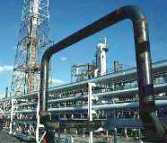NGL profitability weakens amid rising US supply
 Prices for natural gas liquids, or NGLs, have dropped precipitously this year amid growing supplies, weakening the profitability of a key driver of the US shale development.
Prices for natural gas liquids, or NGLs, have dropped precipitously this year amid growing supplies, weakening the profitability of a key driver of the US shale development.
This is according to a quarterly analysis from the oil and gas division of advisory services firm Ernst & Young, who released the report on Tuesday.
Extracting NGLs, such as ethane, propane and butane, is still more attractive than producing dry natural gas, the firm says. But it's not as robust as it was nine months ago.
NGL production has surged in recent years as oil and gas producers dramatically changed their drilling focus from dry to liquids-rich gas in a bid to boost profits.
But supply has outpaced demand, primarily from chemical plants that use NGLs as feedstock for plastics. The result has been lower prices.
“Companies still have plenty of incentive to produce NGLs. Prices remain significantly higher than natural gas. But we're seeing a marked shift in demand,” said Marcela Donadio, Americas oil and gas leader for Ernst & Young. “The market for liquids seems to be leveling out.”
Downstream
 Profit margins for the global refining business strengthened compared to the second quarter as product prices stayed relatively high, the firm said.
Profit margins for the global refining business strengthened compared to the second quarter as product prices stayed relatively high, the firm said.
Much of the recent strength in the global downstream segment has come from improved margins from distillates, such as heating oil, gas oil and diesel fuel. Global distillate demand growth has remained relatively strong, while gasoline demand worldwide has been fairly weak.
Looking ahead, the future for the downstream sector continues to present challenges. A lot of new refining capacity is expected to come online in the next three to five years, which would erode refining margins across the board and could force less-profitable plants in the US and Europe to close.
Gas
Further pressuring the "frac spread" has been the recent increase in natural gas prices, which have been driven upward by improving fundamentals – a slow-down in production growth, increasing demand (particularly in the power sector, where year-to-date gas consumption is up 30%), and a reduction in the massive storage overhang that had persisted over most of the past year.
Spot natural gas prices have climbed over $3.25/MMBtu. While this is about 50% higher than the second quarter, it is still low by historical standards.
After a long time of being significantly above normal levels, natural-gas storage levels in the US are approaching a more average range. This is encouraging for natural gas producers as prices would be strengthened by a cold, early winter and lower storage levels.
Oil
Oil prices remain high, with UK Brent crude trading over $110/bbl and US WTI crude trading over $90/bbl.
Despite worldwide economic uncertainty and growing political tensions in the Middle East, supply and demand have been relatively balanced, with no real supply shortages or supply excesses in sight.
An important recent development is the strong comeback of Iraq's oil production, which reached its highest-level in more than 30 years. Particularly if global oil demand remains relatively weak, this is likely to pressure OPEC members to cut back production in order to make room for Iraq's new output, the firm says.
US oil production continues to grow amid increased shale drilling, but infrastructure bottlenecks remain a serious issue. Defying the historical trend, moving crude by rail has become a crucial piece of the US energy infrastructure and the solution continues to gain ground.
Oilfield services
Spending by oil and gas producers worldwide is still cautiously increasing, but at a slower pace. Drilling in the Gulf of Mexico has come back fairly strongly this year with a steady increase in rigs count.
In the US, total rig count has declined slightly over the last few months as new oil and liquids-directed drilling has not fully offset a continued decline in natural gas drilling. Globally, except for some offshore drilling, cost pressures for oil field services are being somewhat tempered by gains in efficiency.
Transactions
Oil and gas transaction activity in North America was up slightly in the third quarter, driven mainly by the $15.1-billion bid of China's CNOOC for Canada's Nexen. The move underscored the continuing strong interest of Asian companies in North American unconventional oil and gas assets.
Merger and acquisition activity is expected to stay strong as companies with weakened balance sheets and limited cash flows move toward strategic and/or deep-pocketed buyers – in particular, the majors or NOCs.






Comments